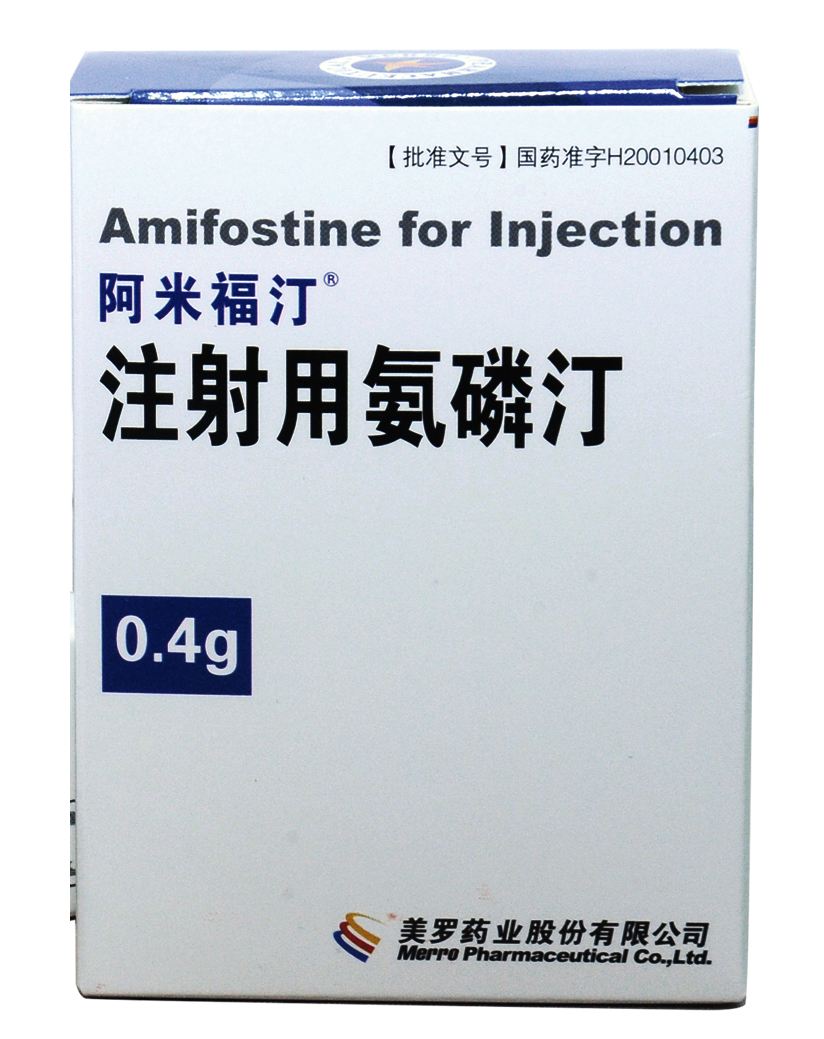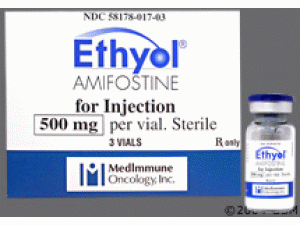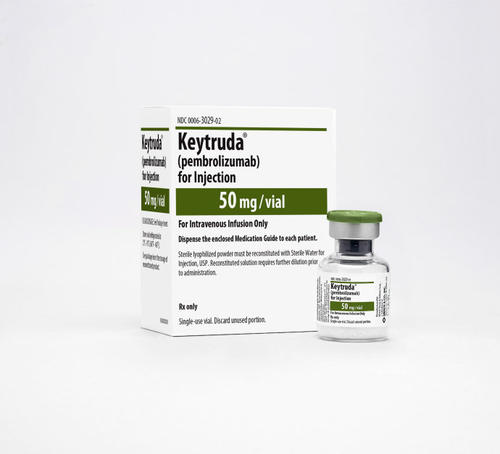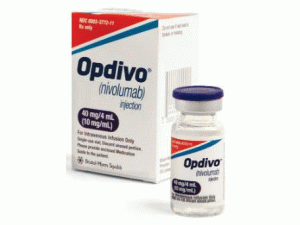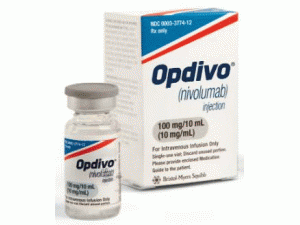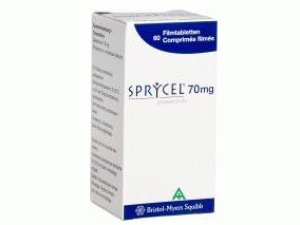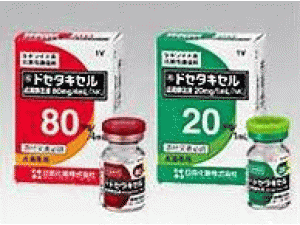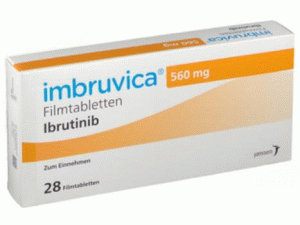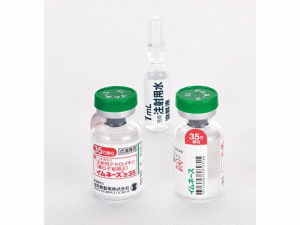阿米福汀晶体粉末注射剂amifostine(Ethyol 500mg vial)
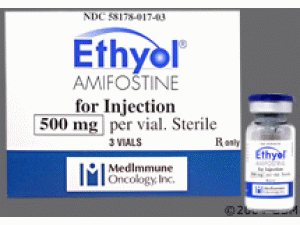 产地国家:美国
处方药:是
所属类别:500毫克/瓶 3瓶/盒
包装规格:500毫克/瓶 3瓶/盒
计价单位:盒
生产厂家英文名:MEDIMMUNE
原产地英文商品名:ETHYOL 500mg/vial 3vials/box
原产地英文药品名:AMIFOSTINE CRYSTALLINE
中文参考商品译名:氨磷汀 500毫克/瓶 3瓶/盒
中文参考药品译名:阿米福汀晶体
产地国家:美国
处方药:是
所属类别:500毫克/瓶 3瓶/盒
包装规格:500毫克/瓶 3瓶/盒
计价单位:盒
生产厂家英文名:MEDIMMUNE
原产地英文商品名:ETHYOL 500mg/vial 3vials/box
原产地英文药品名:AMIFOSTINE CRYSTALLINE
中文参考商品译名:氨磷汀 500毫克/瓶 3瓶/盒
中文参考药品译名:阿米福汀晶体
简介:
英文药名: Ethyol(Amifostine Crystalline Vial)中文药名: 氨磷汀(阿米福汀注射剂)药品简介氨磷汀(amifostine)是1996年FDA批准在美国上市的第二个细胞保护剂(抗辐射药)。商品名为Ethyol,Ethiofos. 通常用多剂量顺铂对晚期卵巢癌或非小细胞肺癌化疗和用环磷酰胺对晚期卵巢癌化疗时,易出现累积肾毒性。本品可预防和减少这种累积肾毒性。 药理作用:药效学本品是硫代磷酸盐的前体药物。它的细胞保护作用是由于正常组织中pH较高、碱基磷酸酯酶活性较强,可将氨磷汀迅速完全地去磷酸化而成游离硫羟基(thiol-)的、有药理活性的代谢物(代号WR-1065),因而保护非肿瘤组织免于化疗和放射疗法的毒性作用,降低环磷酰胺和顺铂对晚期卵巢癌化疗时引起的、与中性白血球减少症有关的感染发生率。正常组织的血液供应较好,提取的氨磷汀多于癌变组织,因而正常组织细胞内活性代谢物WR-1065的浓度较高,可起到区分保护的作用。 药动学:本品的胃肠吸收很差,故不宜口服。在10s内静脉推注本品150mg.m-2后癌症患者的血清药物峰浓度为100~900μmol.L-1,注射后1~4min活性代谢物WR-1 065的峰浓度为7~22μmol.L-1。若给癌症患者以740mg.m-2剂量15min静脉输注本品,则5min内可达到血浆浓度100μmol.L-1,输注结束时可达到100~200μmol.L-1。输注后30min时血浆浓度可下降至10μmol.L-1,45min时为2μmol.L-1左右。本品自血浆中清除迅速,静脉推注或输注后6min内血浆药物水平可下降90%。分布半衰期不到1min,消除半衰期约9min,仅少量原型药物及代谢物自尿中排出。稳态时的平均分布容积为6L。有限的资料表明,以910mg.m-2静脉输注本品后2.5h时,病人骨髓中WR-1065的水平较低,提示为了对抗半衰期较长的细胞毒性药物(如环磷酰胺),需多剂量给予氨磷汀才能起到细胞保护作用。动物实验结果表明,本品在骨髓、胃肠粘膜、皮肤、肝脏及唾液中的浓度较高,而在肌肉中水平较低,脑组织中几乎没有。 适应症:本品可预防顺铂引起的肾毒性和外周神经病,预防环磷酰胺引起的粒细胞白血病和放射疗法引起的骨髓抑制。与顺铂合用可增加顺铂的抗肿瘤效果。用于晚期卵巢癌及转移黑素瘤的放射疗法。亦可用于头颈部癌症、食道癌、肺癌及头部以上的放射疗法。颈动脉病或高钙血症的患者静脉给予本品易发生低血压,建议用较低剂量。 用法用量:建议本品的初始剂量为910mg.m-2,化疗前30min开始静脉输注,输注时间为15min。若收缩压显著低于正常低限则应停止输注。若停药5min内血压恢复正常且患者无任何症状,可继续输注,以使患者获得全部剂量。若患者不能耐受足量氨磷汀,则下一疗程的剂量应减为740mg.m2。本品的最大耐受剂量是每周4d按340mg.m2给予,连续5周。本品为单剂量包装,每支500mg,应冷藏。 不良反应: 本品最重要的不良反应是一过性低血压,在临床研究中约占62%。有低血压的或正处在脱水状态的患者,不得使用本品。正在服用抗高血压药物且24h内不能中断治疗的患者也不能使用本品。给予氨磷汀输注前,应给患者适当水化,静脉补充一些液体。输液氨磷汀的过程中患者应卧床,每隔5min测一次血压。若收缩压明显下降,应立即停药。 恶心或呕吐常发生于氨磷汀输液后,接受顺铂-环磷酰胺化疗第1天并给予本品的患者中有19%出现严重的反应,而未接受本品的患者反应发生率为10%。建议在给予本品之前给予抗呕吐治疗,如地塞米松20mg静注、或5-羟色胺受体阻断剂昂丹司琼和格拉司琼。抗呕吐剂也可与本品合用。 本品可降低血清钙水平,但引致临床上明显的低钙血症发生率低于1%。对有低钙血症危险性的患者(如肾病综合征)应监测血钙水平,必要时补充钙剂。 其它不良反应:面色潮红、寒战、眩晕、嗜睡、呃逆和打喷嚏。皮疹变态反应发生率低于1%。 禁忌:属孕期用药C级(美国FDA颁布的妊娠期间使用药物危险性等级的分类之一,即动物实验证明对胎儿有不良反应——致畸或致死,尚未在孕妇中进行对照研究),因可能危及胎儿而在怀孕期间禁用。 特殊人群用药: 哺乳期:妇女若使用氨磷汀应停止授乳。 本品对儿童和老年人的疗效和安全性尚未知。对氨磷汀、氨硫羟化合物、甘露醇等高敏的不良反应禁用。 警告:不良反应有如下情况时慎用:脑血管病或心血管病、低钙血症的不良反应;有脱水或低血压的不良反应;孕妇和哺乳期妇女;正在服用抗高血压药物且24 h内不能停药者。英文版说明书:
American Society of Clinical Oncology Clinical Practice Guidelines for the Use of Chemotherapy and Radiotherapy ProtectantsAMIFOSTINEAmifostine, formerly known as WR-2721, is a naturally occurring thiol that can protect cells from damage by scavenging oxygen-derived free radicals. This drug arose from a classified nuclear warfare project sponsored by the United States Army and was ultimately selected from a group of more than 4,400 chemicals screened because of its superior radioprotective properties and safety profile. Subsequently, amifostine was eva luated for its potential role in reducing the toxicity of radiation therapy as well as chemotherapeutic agents that alter the structure and function of DNA, such as alkylating agents and platinum agents.A profile emerged from preclinical studies that demonstrated the ability of amifostine to selectively protect almost all normal tissues except the CNS, but not neoplastic tissues, from the cytotoxic effects of some chemotherapeutic agents and radiation therapy.MECHANISM OF ACTION OF AMIFOSTINEAmifostine itself is unable to mediate protection. It is a prodrug that is dephosphorylated to the metabolite, WR-1065, by the plasma membrane–bound enzyme, alkaline phosphatase. Protection of cell damage by WR-1065 is thought to occur through scavenging oxygen-derived free radicals and hydrogen donation to repair damaged target molecules.The mechanism by which amifostine exerts its selective protection of normal tissue is based on the ability of free thiol to be taken up in higher concentration in normal organs than in tumor tissue. The differential uptake of WR-1065 is due to differences in the microenvironment at the tissue level resulting in the slow entry of the free thiol into tumor masses.Tumors are relatively hypovascular, thus resulting in tissue hypoxia, anaerobic metabolism, and a low interstitial pH. The combined hypovascularity and low pH results in low rates of prodrug activation by alkaline phosphatase. In addition, the distribution of alkaline phosphatase in normal and malignant tissue differs, with higher concentrations of this enzyme found in capillaries and arterioles of normal cells and lower levels of alkaline phosphatase found in tumor tissue. Thus selective protection is afforded normal tissues by reduced metabolism of amifostine to the active protector WR-1065 and low uptake by tumors of WR-1065.The end result is as much as a 100-fold greater steady concentration of the free thiol into normal organs such as bone marrow, kidney, salivary glands, and heart, compared with tumor tissue. Once the free thiol WR-1,065 has entered a normal cell, it is available to bind directly to, and thus detoxify, the active species of alkylating agents, platinum agents, or ionizing radiation.CLINICAL USE OF AMIFOSTINEAmifostine is generally well-tolerated and is associated with transient side effects, including nausea, vomiting, sneezing, a warm or flushed feeling, mild somnolence, a metallic taste during infusion, and occasional allergic reactions.Transient emesis associated with amifostine is clearly dose-related and can be moderate in severity, although it is typically of short duration. Emesis is reduced with the preadministration of antiemetics such as ondansetron plus dexamethasone. Transient hypocalcemia has also been reported and is due to inhibition of parathyroid hormone secretion and direct inhibition of bone resorption. The most clinically significant toxicity is hypotension. Although minor declines in blood pressure are fairly common, curtailment of treatment as a result of a significant decline in blood pressure (defined as a decrease in systolic blood pressure > 20 mmHg for over 5 minutes or symptomatic hypotension) is a rare complication that occurs in less then 5% of patients.PREPARATION AND HANDLING AND ADMINISTRATION OF AMIFOSTINEAmifostine is reconstituted with 9.5 mL of sterile 0.9% NaCl for injection to obtain a final concentration of 500 mg/10 mL. It is then administered in a total volume of 50 mL. Amifostine is stable for 6 hours at room temperature and for 24 hours under refrigeration. Amifostine should be administered IV over 15 minutes to patients in a reclining position and should be given within 30 minutes of radiation therapy or chemotherapy. Human pharmacokinetic studies suggest that the plasma half-life of amifostine is approximately 1 minute and that virtually all of the drug is cleared from the plasma within 10 minutes.These pharmacokinetic data are extremely important in the clinical use of this drug. In addition, given the extremely short half-life of amifostine, protection is unlikely with cytotoxic drugs that have a long half-life or drugs that require a prolonged infusion time.Amifostine Use in Radiation Therapy–Associated Complications Xerostomia and MucositisXerostomia and mucositis are major toxicities that are associated with radiation therapy. The risk of these complications is related to the area undergoing radiation, the dose and schedule of radiation therapy, whether radiation therapy is combined with chemotherapy, and a number of host-disease–related factors that are only partially characterized.Although these toxicities are rarely associated with mortality, the morbidity can be quite significant for patients, with acute and long-term consequences. Xerostomia is the most common toxicity associated with standard fractionated radiation therapy to the head and neck region. Whereas acute xerostomia from radiation is due to an inflammatory reaction, late xerostomia, which includes xerostomia occurring 1 year after radiation, reflects fibrosis of the salivary gland and, as such, is usually permanent. Xerostomia results in symptoms of dry mouth; this affects the patient's ability to eat and speak. Additionally, patients with xerostomia are at an increased risk for dental caries, oral infections, and osteonecrosis.The Panel recommends that amifostine may be considered to decrease the incidence of acute and late xerostomia in patients who undergo fractionated radiation therapy in the head and neck region. Present data are insufficient to recommend amifostine to prevent mucositis associated with radiation therapy.The results of numerous phase I studies and a randomized phase II study have suggested that amifostine may protect against radiation-induced toxicity. On the basis of these results, a multi-institutional, international phase III trial of radiation therapy with and without amifostine in 315 patients with head and neck cancer was performed.n this study, eligible patients had squamous cell carcinoma of the head and neck region in which at least 75% of each parotid gland was present in the radiation fields. The amifostine dose was 200 mg/m2/d, via slow IV push over 3 minutes, 15 to 30 minutes before each fraction of radiation therapy. Standard fractionated radiation therapy (1.8 to 2.0 Gy/d for 5 days/wk for 5 to 7 weeks, to a total dose of 50 to 70 Gy) was used in this study. The primary end points of the study were the incidence and severity of radiation-induced toxicities. Amifostine significantly reduced acute xerostomia and late-effect xerostomia and associated symptoms as measured by both physicians (Radiation Therapy Oncology Group criteria and saliva sampling) and patients (quality-of-life questionnaire). Using Radiation Therapy Oncology Group criteria, the incidence of grade 2 or higher acute xerostomia was reduced from 78% to 51% (P < .0001), and the incidence of grade 2 or higher late-effect xerostomia was reduced from 57% to 34% (P = .0019). The percentage of patients with no meaningful saliva production at 1 year was significantly reduced from 51% to 28% (P = .0033). Although there was a trend favoring the amifostine arm with respect to severity of mucositis (P = .1442), the difference in the incidence of grade 3 or higher mucositis was not statistically significant (P = .4767). Importantly, at 1 year, the locoregional tumor control rates were not different with a median follow-up of 20 months, and the disease-free and overall survival curves are comparable. Side effects associated with amifostine included nausea, vomiting, and hypotension.In a much smaller clinical study, Liu reported the results of a randomized study conducted in China that eva luated the use of amifostine and radiotherapy in 100 patients with locally advanced rectal cancer. Patients were randomized to treatment with daily fractionated radiation therapy with or without amifostine (340 mg/m2 before each fraction of radiation). Pretreatment with amifostine had no impact on the incidence of acute radiation toxicity, although there was a statistically significant difference in the incidence of moderate or severe late toxicities (alterations in bladder or gastrointestinal mucosa): 0% (0 of 34 patients) in the amifostine and radiation therapy arm versus 14% (five of 37 patients) in the radiation therapy–alone arm (P = 0.03).The results of a phase II randomized trial of amifostine in patients with squamous cell carcinoma of the head and neck region who receive carboplatin and radiotherapy also suggest that amifostine may protect against radiation-induced toxicities. In this study, 28 patients received radiation therapy (up to a total of 60 Gy) in conjunction with carboplatin (70 mg/m2 on days 1 through 5 and days 21 through 26). Amifostine was administered to 14 patients on the day of carboplatin at a fixed dose of 500 mg (equivalent range of 250 to 340 mg/m2). At the completion of therapy, none of the amifostine-treated patients but 12 of 14 patients (86%) treated with radiation/chemotherapy alone experienced grade 3/4 mucositis (P = .0001). Additionally, 17% of patients who were pretreated with amifostine had grade 2 xerostomia, compared with 55% of the patients receiving chemotherapy and radiation therapy without amifostine (P = .05). Mucositis is a significant problem in patients who receive chemotherapy and radiation therapy. The majority of patients who receive radiation therapy to the head and neck area develop oral complications, including mucositis, which is not only painful but can also prevent patients from obtaining adequate nutrition.Guideline: When given with radiation therapy, the recommended amifostine dose is 200 mg/m2/d given as a slow IV push over 3 minutes, 15 to 30 minutes before each fraction of radiation therapy. Administration of amifostine requires close patient monitoring, but side effects are fewer at this lower dose. Many patients require antiemetics. Blood pressure should be measured just before and immediately after the 3-minute amifostine infusion. The hypotension associated with amifostine at this dose is less frequent but still requires close monitoring.In the setting of amifostine with radiation therapy, there are two randomized phase III clinical trials that used different doses of amifostine. In the trial in patients with head and neck cancer who received radiation therapy with and without amifostine, which showed protection against xerostomia, the dose of amifostine was 200 mg/m2. In the small study of patients with rectal cancer who were treated with radiation therapy alone or radiation therapy with amifostine, the dose of amifostine was 340 mg/m2. Ongoing studies of amifostine as a radiation protector all use an amifostine dose of 200 mg/m2. Therefore, based primarily on the data from the largest phase III study, which suggests a benefit of amifostine in preventing toxicities associated with radiation therapy, the recommended dose of amifostine is 200 mg/m2 administered before each fraction of radiation therapy.Extensive preclinical studies confirm the protective effect of amifostine against radiation therapy. Radioprotective activity of amifostine has been seen against jejunum, colon, lung, and bone marrow in laboratory and animal studies. This led to a series of clinical studies that suggest that amifostine pretreatment is associated with reduced complications from radiation therapy.A daily dose of amifostine of 340 mg/m2 given four times a week for 5 weeks before radiation therapy was determined from phase II studies with radiation. More recently, investigators have used a dose of 200 mg/m2/d before each fraction of radiotherapy to minimize gastrointestinal side effects associated with amifostine treatment.Journal of Clinical Oncology, Vol 18, Issue 19 (October), 2000: 3339-3345Phase III Randomized Trial of Amifostine as a Radioprotector in Head and Neck CancerDavid M. Brizel Patients with previously untreated head and neck squamous cell carcinoma were eligible. Primary end points included the incidence of grade 2 acute xerostomia, grade 3 acute mucositis, and grade 2 late xerostomia and were based on the worst toxicity reported. Amifostine was administered (200 mg/m2 intravenous) daily 15 to 30 minutes before irradiation. Radiotherapy was given once daily (1.8 to 2.0 Gy) to doses of 50 to 70 Gy. Whole saliva production was quantitated preradiotherapy and regularly during follow-up. Patients eva luated their symptoms through a questionnaire during and after treatment. Local-regional control was the primary antitumor efficacy end point.RESULTS: Nausea, vomiting, hypotension, and allergic reactions were the most common side effects. Fifty-three percent of the patients receiving amifostine had at least one episode of nausea and/or vomiting, but it only occurred with 233 (5%) of 4,314 doses. Amifostine reduced grade 2 acute xerostomia from 78% to 51% (P < .0001) and chronic xerostomia grade 2 from 57% to 34% (P = .002). Median saliva production was greater with amifostine (0.26 g v 0.10 g, P = .04). Amifostine did not reduce mucositis. With and without amifostine, 2-year local-regional control, disease-free survival, and overall survival were 58% versus 63%, 53% versus 57%, and 71% versus 66%, respectively.Journal of Clinical Oncology, Vol 18, Issue 11 (June), 2000: 2226-2233Subcutaneous Administration of Amifostine During Fractionated Radiotherapy: A Randomized Phase II StudyBy Michael I. Koukourakis, George Kyrias, Stelios Kakolyris, Charalambos Kouroussis, Chryssi Frangiadaki, Alexandra Giatromanolaki, George Retalis, Vassilios GeorgouliasFrom the Department of Radiotherapy/Oncology and Medical Oncology, University Hospital of Iraklion, and Tumour and Angiogenesis Research Group, Iraklion, and Schering Plough SA, Agiou Dimitriou, Alimos, Greece.PURPOSE: Amifostine (WR-2721) is an impotant cytoprotective agent. Although intravenous administration is the standard route, pharmacokinetic studies have shown acceptable plasma levels of the active metabolite of amifostine (WR-1605) after subcutaneous administration. The subcutaneous route, due to its simplicity, presents multiple advantages over the intravenous route when amifostine is used during fractionated radiotherapy.PATIENTS AND METHODS: Sixty patients with thoracic, 40 with head and neck, and 40 with pelvic tumors who were undergoing radical radiotherapy were enrolled onto a randomized phase II trial to assess the feasibility, tolerance, and cytoprotective efficacy of amifostine administered subcutaneously. A flat dose of amifostine 500 mg, diluted in 2.5 mL of normal saline, was injected subcutaneously 20 minutes before each radiotherapy fraction.RESULTS: The subcutaneous amifostine regimen was well tolerated by 85% of patients. In approximately 5% of patients, amifostine therapy was interrupted due to cumulative asthenia, and in 10%, due to a fever/rash reaction. Hypotension was never noted, whereas nausea was frequent. A significant reduction of pharyngeal, esophageal, and rectal mucositis was noted in the amifostine arm (P < .04). The delays in radiotherapy because of grade 3 mucositis were significanly longer in the group of patients treated with radiotherapy alone (P < .04). Amifostine significantly reduced the incidence of acute perineal skin and bladder toxicity (P < .0006).CONCLUSION: Subcutaneous administration of amifostine is well tolerated, effectively reduces radiotherapy’s early toxicity, and prevents delays in radiotherapy. The subcutaneous route is much simpler and saves time compared with the intravenous route of administration and can be safely and effectively applied in the daily, busy radiotherapy practice.Prophylactic use of amifostine to prevent radiochemotherapy-induced mucositis and xerostomia in head-and-neck cancer. Dosia Antonadou. International Journal of Radiation Oncology*Biology*Physics, 2002;52:3 : 739-747To determine the prophylactic properties of amifostine against acute and late toxicities from radiochemotherapy in patients with head-and-neck cancer.Fifty patients were randomized to receive conventional radiotherapy (RT) (2-Gy fractions, 5 days weekly, to a total of 60–74 Gy, depending on the tumor localization and TNM classification) and carboplatin (90 mg/m2 infusion once per week before RT). Amifostine (300 mg/m2) was administered in the study group only 15–30 min before RT for 6–7.5 weeks. The primary study end point was the grading of acute and late nonhematologic toxicities (mucositis, dysphagia, xerostomia) induced by radiochemotherapy. Secondary end points included treatment duration, hematologic toxicity, and clinical outcome.The treatment duration was significantly shorter in the amifostine-treated group (p = 0.013), because treatment interruptions were more frequent in the control group. Acute toxicities (mucositis and dysphagia) were less severe in the amifostine-treated group. By Week 3, all in the control group experienced Grade 2 mucositis compared with only 9% in the amifostine-treated group (p <0.0001). By Week 5, 52.2% of the patients in the control group experienced Grade 4 mucositis compared with 4.5% in the amifostine-treated group (p = 0.0006). Similar results were obtained for dysphagia. At 3 months of follow-up, only 27% of patients in the study group experienced Grade 2 xerostomia compared with 73.9% in the control group (p = 0.0001). Eighteen months after cessation of therapy, the proportion of patients with Grade 2 xerostomia was 4.5% vs. 30.4% for each respective treatment group (p = 0.047). Cytoprotection with amifostine did not affect treatment outcome, with 90.9% complete responses in the amifostine-treated group compared with 78.3% in the control group (p = 0.414). Amifostine was effective in reducing mucositis and dysphagia resulting from radiochemotherapy in patients with head-and-neck cancer. Furthermore, amifostine reduced the severity of late xerostomia, a side effect of RT with long-lasting consequences. Amifostine treatment did not affect the clinical outcome.A randomized study of very accelerated radiotherapy with and without amifostine in head and neck squamous cell carcinoma.J. Bourhis, International Journal of Radiation Oncology*Biology*Physics, 2000;46:5 : 1105-1108The aim of this study was to assess whether amifostine could minimize acute mucositis induced by a very accelerated irradiation regimen in patients with advanced head and neck squamous cell carcinoma (HNSCC). Between May 1996 and February 1998, 26 patients with an inoperable nonmetastatic Stage IV HNSCC were entered in this study. The treatment consisted of very accelerated radiotherapy given 64 Gy in 3.5 weeks. The patients were randomized to receive or not 150 mg/m2, amifostine (Ethyol, U.S. Bioscience) 15–30 min prior to each radiation session. Of the 13 patients who received amifostine, definitive interruption of amifostine occurred in 5 cases (38%), due to tolerance problems (vomiting, liver enzyme elevation, generalized erythema). The distribution of Grade 4 mucositis (WHO) was 1 case versus 8 cases, with and without amifostine, respectively. The mean duration of ''at least Grade 3'' mucositis (WHO) was 25.1 days versus 49.2 days with and without amifostine (p = 0.03). In the amifostine group, 11/13 of the patients required a feeding tube (nasogastric tube or medical gastrostomy), because of acute mucositis, whereas in the control group a feeding tube was necessary in all cases. The mean duration of the use of this feeding tube was 1 month versus 2.5 months with and without amifostine respectively (p < 0.01). Local-regional control was not different between both arms with a median follow-up of 15 months. Despite the limited number of patients, this pilot randomized study suggests that amifostine was able to markedly reduce the severity and duration of mucositis induced by very accelerated radiotherapy. However, the tolerance of this twice daily amifostine schedule was relatively poor.用药温馨提示:当您服用此药物时,需定期接受医疗专业人士的检查,以便随时针对其药效、副作用等情况进行监测。本网站所包含的信息旨在为患者提供帮助,不能代替医学建议和治疗。
药品价格查询,专业药品查询网站,药品说明书查询,药品比价 » 阿米福汀晶体粉末注射剂amifostine(Ethyol 500mg vial)
药品价格查询,专业药品查询网站,药品说明书查询,药品比价 » 阿米福汀晶体粉末注射剂amifostine(Ethyol 500mg vial)

